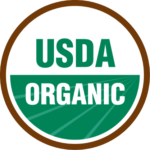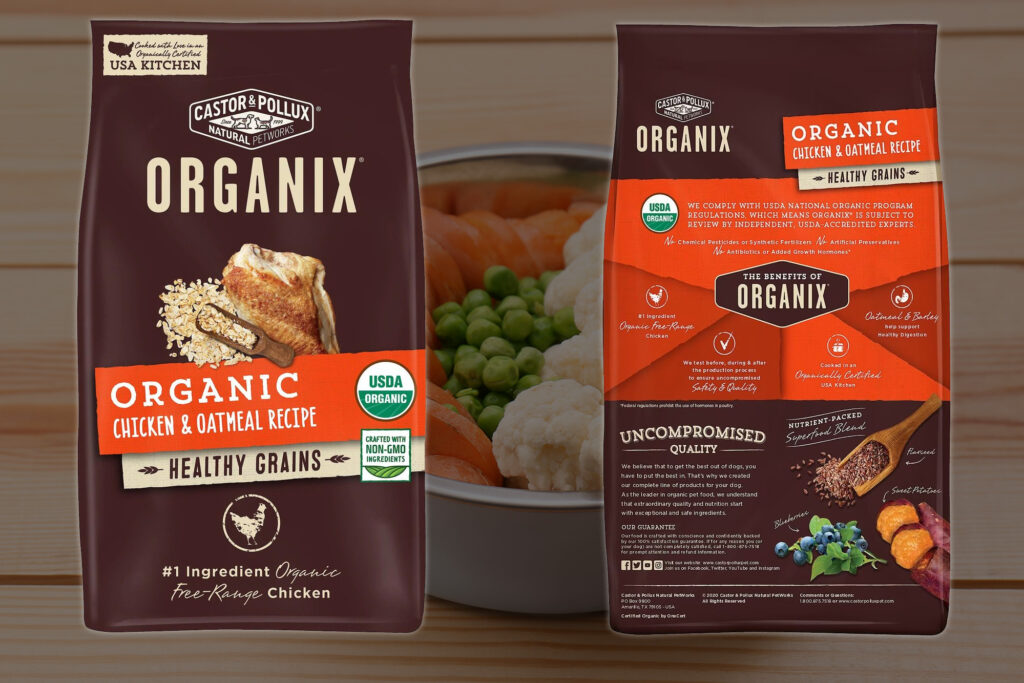If you love your dog like family, you’re likely cautious about what you feed them—just as you are for yourself. You’ve probably seen organic dog food at stores or online and wondered, “Is this better for my dog?“
In this guide, we’ll answer key questions about organic dog food:
- What makes dog food ‘organic’?
- Why does it cost more?
- Are there proven health benefits?
- Is it safer or recommended by vets?
It’s important to know what you’re getting, especially when your dog’s health is at stake. You might be surprised to find out that there’s currently no solid scientific evidence showing organic dog food is healthier than conventional options. In other words, the extra money spent on organic might not bring your dog added benefits.
So, let’s dive into the facts, hear from experts, and give you the information you need for the best choice for your furry friend.
Ready to be a well-informed dog parent? Let’s get started!
What is Organic Dog Food?

Definition and Criteria for Organic Dog Food
When we say “organic dog food,” we mean products that follow specific rules about farming and production. These rules are put in place by the USDA. Note that the USDA only has one seal for “organic food”, there are no rules made just for organic pet food. So any organic dog food meets the same criteria as organic human food!
For a dog food to earn an “organic” label, at least 95% of its ingredients must be organic. If the label says “made with organic ingredients,” that number drops to at least 70%.
In simple terms, ‘organic’ means the ingredients are grown without synthetic fertilizers or synthetic pesticides, and they’re not genetically modified or exposed to certain chemicals in the making process.
Differences Between Organic and Non-Organic Dog Food
- Ingredients: The biggest difference is where the ingredients come from. Organic dog food uses ingredients grown with organic farming, which avoids synthetic fertilizers and pesticides. Non-organic dog food uses ingredients that might be grown with these synthetic materials.
- Pesticides and Residue Levels: People often choose organic to avoid synthetic pesticides. But remember, organic doesn’t mean pesticide-free. It just uses different kinds, usually natural ones. And the amount of pesticide residue can vary a lot, whether it’s organic or not.
- Genetically Modified Organisms (GMOs): Organic dog food doesn’t use GMOs. These are organisms that were changed in ways that don’t happen naturally. Non-organic dog food might include GMOs. However, there’s no evidence that GMOs are harmful to pets or people.
- Nutritional Content: Some think organic food has better nutrients, but science doesn’t back this up. According to reliable sources like Tufts University and Dr. Gretchen Verheggen, DMV, the nutrient levels in organic and non-organic dog foods are pretty much the same. There’s also no solid proof saying organic dog food is healthier.
- Environmental Impact: Organic and non-organic foods have different effects on the environment. For example, organic farming often needs more land for the same amount of food, which could be a downside for sustainability.
- Cost: Organic dog food usually costs more because of the farming methods and the cost of getting certified as organic. We’ll talk more about why it’s more expensive in the next section.
Why Organic Dog Food is More Expensive
Have you ever wondered why organic dog food costs more than regular dog food? You’re not alone. Many people question if the extra dollars are worth it. Let’s unpack why organic options come with a higher price tag.
Organic Farming is Costlier
There are many factors that go into organic farming being a more costly process.
- More Labor: Organic farming usually involves more hands-on work. Since they don’t use synthetic fertilizers or pesticides, tasks like hand-weeding are common and raise labor costs.
- Quality Ingredients: Organic foods tend to use premium, often pricier, ingredients from farms that follow strict organic rules.
- Lower Yields: Organic farms often produce less food per acre than conventional ones that use synthetic aids. Fewer yields can mean higher prices for you.
- Soil Care: Organic farming puts a premium on soil health, making soil preparation and maintenance more involved and costly.
- Animal Welfare: If the food includes animal ingredients, organic rules often require better living conditions and natural diets for livestock. These standards can also add to the cost.
Organic Certification Isn’t Cheap

Getting an organic certification takes time and money. Farms need to meet tough rules and undergo thorough reviews. They often face costs for inspections, admin work, and regular audits. These costs usually get passed on to you, the consumer.
Small-Scale Production Adds Up
Many organic products come from smaller farms and facilities. These smaller operations don’t have the cost benefits that big farms do. Plus, they may not have the same distribution and retail reach, adding more to the final price.
In conclusion, organic dog food often costs more due to the farming methods, the certification process, and the smaller scale of production. But it’s crucial to ask if the higher price brings actual benefits for your pet. As we’ve noted, there’s currently no strong scientific proof showing that organic dog food offers significant health advantages.
Scientific Evidence on Organic Dog Food
When it comes to the health and well-being of our four-legged friends, it’s crucial to separate facts from beliefs or marketing hype. The rising popularity of organic dog food has many pet parents wondering if it’s worth the investment. But what does science have to say on this matter? Let’s dive into the existing research and expert opinions to get a clearer picture.
Summary of Existing Research on Benefits of Organic Food for Dogs
The scientific community has not produced any substantial evidence to support the idea that organic dog food offers specific health benefits over non-organic options. Studies examining nutrient differences between organic and conventional foods have generally found that these differences are minimal. This holds true for both human and pet foods.
The lack of specific regulations for organic pet foods also raises questions about the consistency and standardization of these products. Some proponents argue that organic food could have a lower risk of contamination from synthetic pesticides or fertilizers, but organic foods are not necessarily pesticide-free; they often use different types of pesticides that are deemed ‘natural.’
Expert Opinions and Veterinary Insights

Leading veterinary experts and academic institutions have mirrored this sentiment. Both sources confirm that while the nutrient differences between organic and conventional dog foods are generally small, there’s no concrete evidence to suggest any significant health benefits from choosing organic.
Veterinarians generally recommend focusing on the nutritional balance of a pet’s diet rather than whether or not it’s organic. The key is to select a diet that meets the nutritional requirements laid out by organizations like the Association of American Feed Control Officials (AAFCO), which sets standards for the quality and safety of pet food in the United States. Whether organic or not, any diet should meet these basic criteria to ensure your dog’s well-being.
Conclusion: No Studied Benefit for Either Humans or Dogs for Choosing Organic
In summary, while the idea of feeding your dog organic food may be appealing for various reasons, such as perceived environmental benefits or a desire to feed your pet a ‘natural’ diet, there’s no scientific evidence to suggest that organic dog food is inherently healthier or more nutritious than non-organic options. Therefore, the extra expense associated with organic dog food may not bring added benefits in terms of your pet’s health.
As always, consult with your veterinarian to determine the best dietary options for your dog, keeping in mind factors like age, weight, activity level, and any specific health conditions your pet may have. But when it comes to the organic label, it appears that you’re paying a premium without a guaranteed return on your pet’s health.
Given that organic dog food often comes with a higher price tag, understanding the regulations behind the label can help ensure you’re getting your money’s worth. Here’s what to know about the oversight involved, certification processes, and the importance of label literacy.
How Does Organic Certification Work for Dog Food?
The USDA is the primary regulatory body for organic foods, including pet foods. To be labeled as ‘organic,’ dog food must follow USDA guidelines intended for human foods. Although no guidelines are specifically designed for organic pet foods, complying with USDA regulations is the closest thing to official oversight available.
Some third-party agencies, accredited by the USDA, also perform inspections and audits to verify that facilities meet the standards required for organic certification.
What Certification Involves
Earning the ‘organic’ label isn’t straightforward; it involves multiple criteria such as:
- Ingredient Sourcing: For a “certified organic” label, at least 95% of ingredients must be organic.
- Farming Practices: Ingredients must be grown without synthetic fertilizers, pesticides, or GMOs.
- Animal Welfare: If animal-based ingredients are included, they must come from animals raised under specific, generally more humane, conditions.
- Processing: Artificial preservatives and certain chemicals must be avoided during manufacturing.
- Inspections: Routine checks and audits are conducted to maintain compliance with these standards.
Why Reading Labels Matters
In the absence of specific regulations for organic pet foods, it’s vital to read labels with a discerning eye. Terms can be misleading. For example, “made with organic ingredients” means only 70% of the ingredients need to be organic. The remaining 30% could include synthetic chemicals or GMOs.
Always look for the official USDA organic seal. If you’re still unsure, consider researching the manufacturer or consulting your vet for advice.
In summary, while some regulations do exist for organic dog food, they’re not as strict or specialized as you might think. Being a well-informed consumer involves understanding these regulations, scrutinizing labels, and staying updated on the roles of various agencies.
Closing Thoughts on Organic Dog Food
Selecting the appropriate food for your dog is a pivotal choice affecting their overall health and well-being. Organic dog food, with its allure of high-quality and ‘natural’ ingredients, might seem worth the additional expense. However, it’s essential to discern fact from marketing hype.
Current scientific studies and expert opinions have yet to demonstrate that organic dog food offers any notable health advantages over traditional options. The nutrient content between the two categories is generally similar. While organic dog food does follow certain farming and manufacturing criteria, the absence of regulations specifically for pet foods means you should scrutinize labels diligently.
The elevated cost of organic dog food is mainly due to organic farming methods, certification expenses, and often smaller production scales. However, these factors don’t necessarily provide proven health benefits for your pet.
In conclusion, if you’re contemplating the shift to organic dog food, it’s vital to balance the potential perks against the increased costs. Consult your veterinarian to create a diet that addresses your dog’s unique nutritional requirements. As it currently stands, the ‘organic’ label doesn’t assure a nutritionally superior product. Prioritize your dog’s health by making well-informed decisions rather than succumbing to marketing narratives or prevailing fads.
There are no studies showing organic dog food to be better or worse for pets (or for people).

